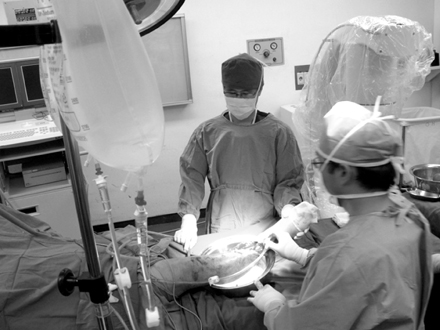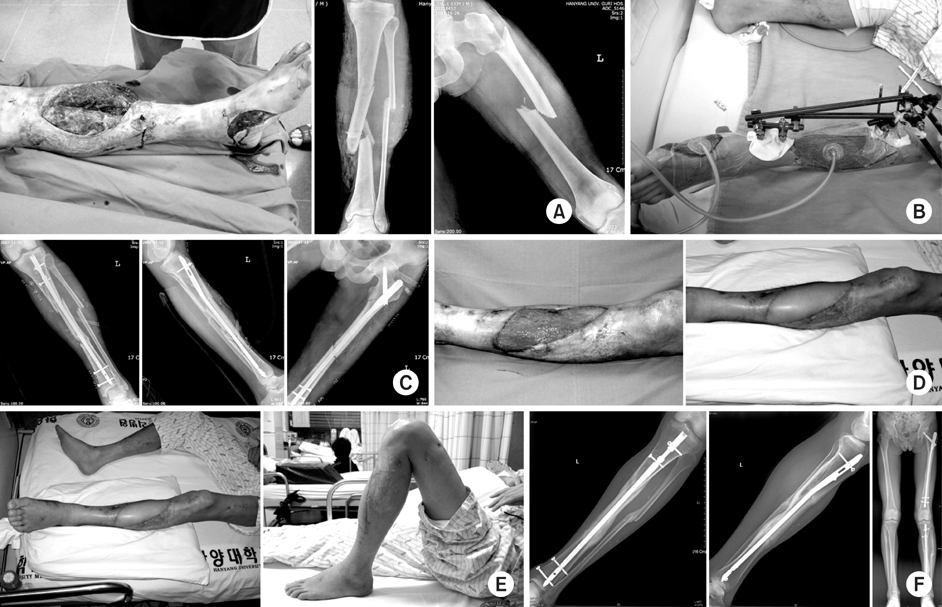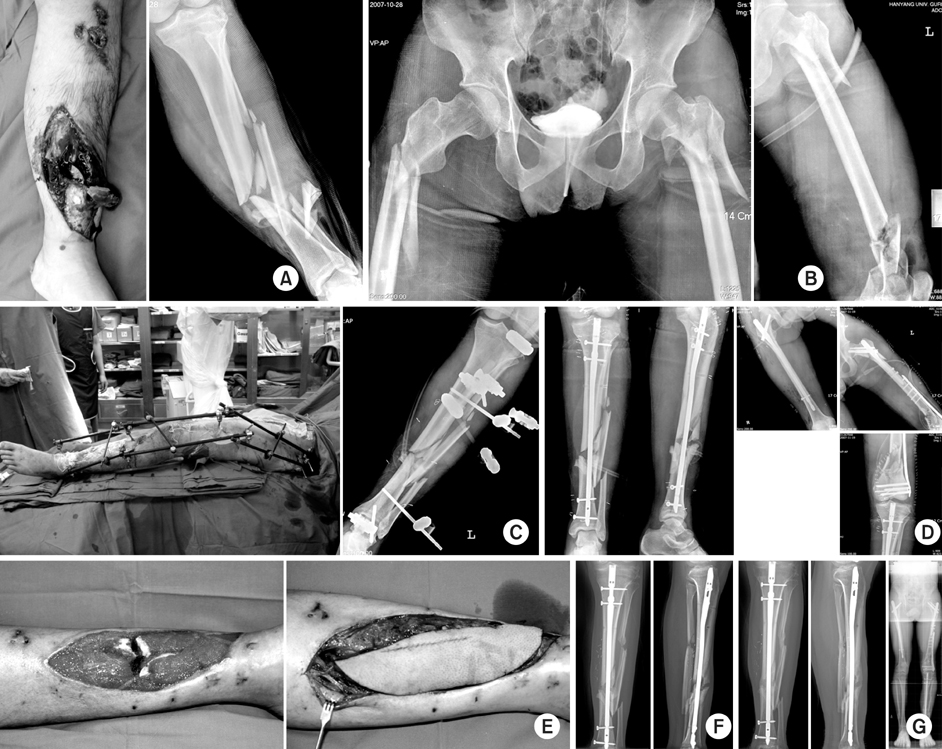Articles
- Page Path
- HOME > J Musculoskelet Trauma > Volume 23(1); 2010 > Article
-
Review Article from Symposium
- Acute Management of Soft Tissue Defect in Open Fracture
- Ki-Chul Park, M.D.
-
Journal of the Korean Fracture Society 2010;23(1):155-159.
DOI: https://doi.org/10.12671/jkfs.2010.23.1.155
Published online: January 31, 2010
- Address reprint requests to: Ki-Chul Park, M.D. Department of Orthopaedic Surgery, Guri Hospital, Hanyang University College of Medicine, 249-1, Gyomoon-dong, Guri 471-701, Korea. Tel: 82-31-560-2318, Fax: 82-31-557-8781, kcpark@hanyang.ac.kr
Copyright © 2010 The Korean Fracture Society
- 423 Views
- 1 Download
- 3 Crossref
- 1. Anglen JO. Wound irrigation in musculoskeletal injury. J Am Acad Orthop Surg, 2001;9:219-226.Article
- 2. Anglen JO, Apostoles S, Christensen G, Gainer B. The efficacy of various irrigation solution in removing slime-producing staphylococcus. J Orthop Trauma, 1994;8:390-395.
- 3. Argenta LC, Morykwas MJ. Vacuum-assisted closure: a new method for wound control and treatment: clinical experience. Ann Plast Surg, 1997;38:563-576.Article
- 4. Beardmore AA, Brooks DE, Wenke JC, Thomas DB. Effectiveness of local antibiotic delivery with an osteoinductive and osteoconductive bone-graft substitute. J Bone Joint Surg Am, 2005;87:107-112.Article
- 5. Dedmond BT, Kortesis B, Punger K, et al. The use of negative-pressure wound therapy in temporary treatment of soft tissue injuries associated with high energy open tibial shaft fractures. J Orthop Trauma, 2007;21:11-17.
- 6. Godina M. Early microsurgical reconstruction of complex trauma of the extremities. Plast Reconstr Surg, 1986;78:285-292.Article
- 7. Gopal S, Majumder S, Batchelor AG, Knight SL, De Boer P, Smith RM. Fix and flap: the radial orthopsecid and plastic treatment of severe open fractures of the tibia. J Bone Joint Surg Br, 2000;82:959-966.
- 8. Henry SL, Ostermann PA, Seligson D. The antibiotic bead pouch technique, the management of severe compound fractures. Clin Orthop Relat Res, 1993;295:54-62.
- 9. Joseph E, Hamori CA, Bergman S, Roaf E, Swann NF, Anastasi GW. A prospective randomized trial of vacuum-assisted closure versus standard therapy of chronic non-healing wounds. Wounds, 2000;12:60-67.
- 10. Lee KB, Choi J, Moon ES, Yoon TR, Lim KY. Negative pressure wound therapy for traumatic soft tissue defects. J Korean Fract Soc, 2006;19:67-71.Article
- 11. Lionelli GT, Lawrence WT. Wound dressings. Surg Clin North Am, 2003;83:617-638.Article
- 12. McKee MD, Wild LM, Schemitsch EH, Waddell JP. The Use of an antibiotic-impregnated, osteoconductive, bioabsorbable bone substitute in the treatment of infected long bone defects: early results of a prospective trial. J Orthop Trauma, 2002;16:622-627.Article
- 13. Morykwas MJ, Argenta LC, Shelton-Brown EI, McGuirt W. Vacuum-assisted closure: a new method for wound control and treatment: animal studies and basic foundation. Ann Plast Surg, 1997;38:553-562.
- 14. Patzakis MJ, Bains RS, Lee J, et al. Prospective, randomized, double-blind study comparing sigle-agent antibiotic therapy, ciprofloxacin, to combination antibiotic therapy in open fracture wounds. J Orthop Trauma, 2000;14:529-533.
- 15. Steiert AE, Gohritz A, Schreiber TC, Krettek C, Vogt PM. Delayed flap coverage of open extremity fractures after previous vacuum assisted closure therapy-worse or worth? J Plast Reconstr Aesthet Surg, 2009;62:675-683.
- 16. Webb LX. New techniques in wound management: vacuumassisted wound closure. J Am Acad Orthop Surg, 2002;10:303-311.Article
- 17. Zalavras CG, Patzakis MJ, Holtom P. Local antibiotic therapy in the treatment of open fractures and osteomyelitis. Clin Orthop Relat Res, 2004;427:86-93.Article
REFERENCES
Fig. 1Continuous gravity irrigation is effective at removing bacteria with less structural damage to bone when compared with high-pressure pulsatile lavage.


Fig. 2
(A) A 34 year-old man sustained type IIIB open tibia shaft fracture combined with closed segmental femur fracture.
(B) The VAC system was applied to the open wound after debridement and temporary external fixation.
(C) Unreamed tibial nailing and reamed femoral nailing were performed at two weeks after injury.
(D) Anterolateral thigh flap was applied at twenty five days after injury.
(E) Good functional result without infection was showed at 4 months after injury.
(F) The fractures were healed without complication.


Fig. 3
(A, B) 31 year-old man sustained type IIIB open tibia shaft fracture combined with both femur and head trauma. The hemodynamic state was unstable.
(C) The VAC system was applied to the open wound after debridement and temporary external fixation which was damaged controlled surgery.
(D) Unreamed tibial nail, femoral nails and plate were applied at two weeks after injury.
(E) Anterolateral thigh flap was applied at twenty one days after injury.
(F) Autogenous iliac bone graft was applied to the bone defect at 2 months after injury to increase bone healing.
(G) The fractures were healed without complication.


Figure & Data
REFERENCES
Citations
Citations to this article as recorded by 

- Treatment of Type IIIb Open Tibial Fractures
Seong Yeon Lim, Il Jae Lee, Jae Ho Joe, Hyung Keun Song
Journal of the Korean Fracture Society.2014; 27(4): 267. CrossRef - A Case Report of patient underwent Debridement caused by Cellulitis improved with Gamisunbangwhalmyung-Eum
Yong-Ju Choi, Hueon-Jin Bae, Seok-Hoon Hong
The Journal of Korean Oriental Medical Ophthalmology and Otolaryngology and Dermatology.2013; 26(4): 111. CrossRef - Management of Open Fracture
Gu-Hee Jung
Journal of the Korean Fracture Society.2010; 23(2): 236. CrossRef
Acute Management of Soft Tissue Defect in Open Fracture



Fig. 1
Continuous gravity irrigation is effective at removing bacteria with less structural damage to bone when compared with high-pressure pulsatile lavage.
Fig. 2
(A) A 34 year-old man sustained type IIIB open tibia shaft fracture combined with closed segmental femur fracture.
(B) The VAC system was applied to the open wound after debridement and temporary external fixation.
(C) Unreamed tibial nailing and reamed femoral nailing were performed at two weeks after injury.
(D) Anterolateral thigh flap was applied at twenty five days after injury.
(E) Good functional result without infection was showed at 4 months after injury.
(F) The fractures were healed without complication.
Fig. 3
(A, B) 31 year-old man sustained type IIIB open tibia shaft fracture combined with both femur and head trauma. The hemodynamic state was unstable.
(C) The VAC system was applied to the open wound after debridement and temporary external fixation which was damaged controlled surgery.
(D) Unreamed tibial nail, femoral nails and plate were applied at two weeks after injury.
(E) Anterolateral thigh flap was applied at twenty one days after injury.
(F) Autogenous iliac bone graft was applied to the bone defect at 2 months after injury to increase bone healing.
(G) The fractures were healed without complication.
Fig. 1
Fig. 2
Fig. 3
Acute Management of Soft Tissue Defect in Open Fracture

 E-submission
E-submission KOTA
KOTA TOTA
TOTA TOTS
TOTS
 Cite
Cite

